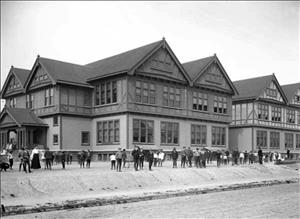In 1890, the Lowell School opens on Seattle's future Capitol Hill (Mercer Street and Federal Avenue) with the name Pontius School. By 1892 the name has changed to Columbia School and the school employs seven teachers to teach 261 pupils. In 1902, 12 teachers are teaching 469 scholars in eight grades. In 1910, to alleviate confusion with the Columbia School in the recently annexed Columbia City neighborhood of Seattle, the name is changed to the Lowell School. It is named after the American poet, essayist, and diplomat James Russell Lowell (1819-1891).
Capitol Hill's First Grade School
The hopes and statistics connected with establishing the first grade school is perhaps the best clue of a neighborhood's early development. In 1889, the year of Seattle's "Great Fire,"enough families lived on the ridge northeast of town that a school was planned for and opened the following year on the still remote corner of Mercer Street and Federal Avenue.
At the time only two families with children lived north of the school that was first named Pontius in honor of the family on whose addition it was built. In 1891, Columbia School its second of three names employed seven teachers for its 261 students, grades one through six. The considerable convenience of the Union Trunk Line's electric trolley also arrived in 1891, running down the center of the still rough Broadway and 10th avenues as far as Lynn Street from its connection on First Hill with the James Street trolley.
Growth and Change
In the following decade as the Seattle population doubled so too nearly would attendance at the school. During the 1890s, the faculty watched as the neighborhood was filled in with homes along streets graded if not yet paved. In 1902, 12 teachers taught 469 scholars, now in eight grades.
The school got its last name change in 1910 from Columbia to Lowell. The 1907 incorporation of Columbia City into Seattle included its own Columbia School and the ensuing confusion was tolerated for two years more.
In 1959, the then nearly 70-year-old gabled structure was the oldest school house still in use. It was destroyed the following year and replaced by a new addition just north of the brick school house that had been added to the site in 1919.

